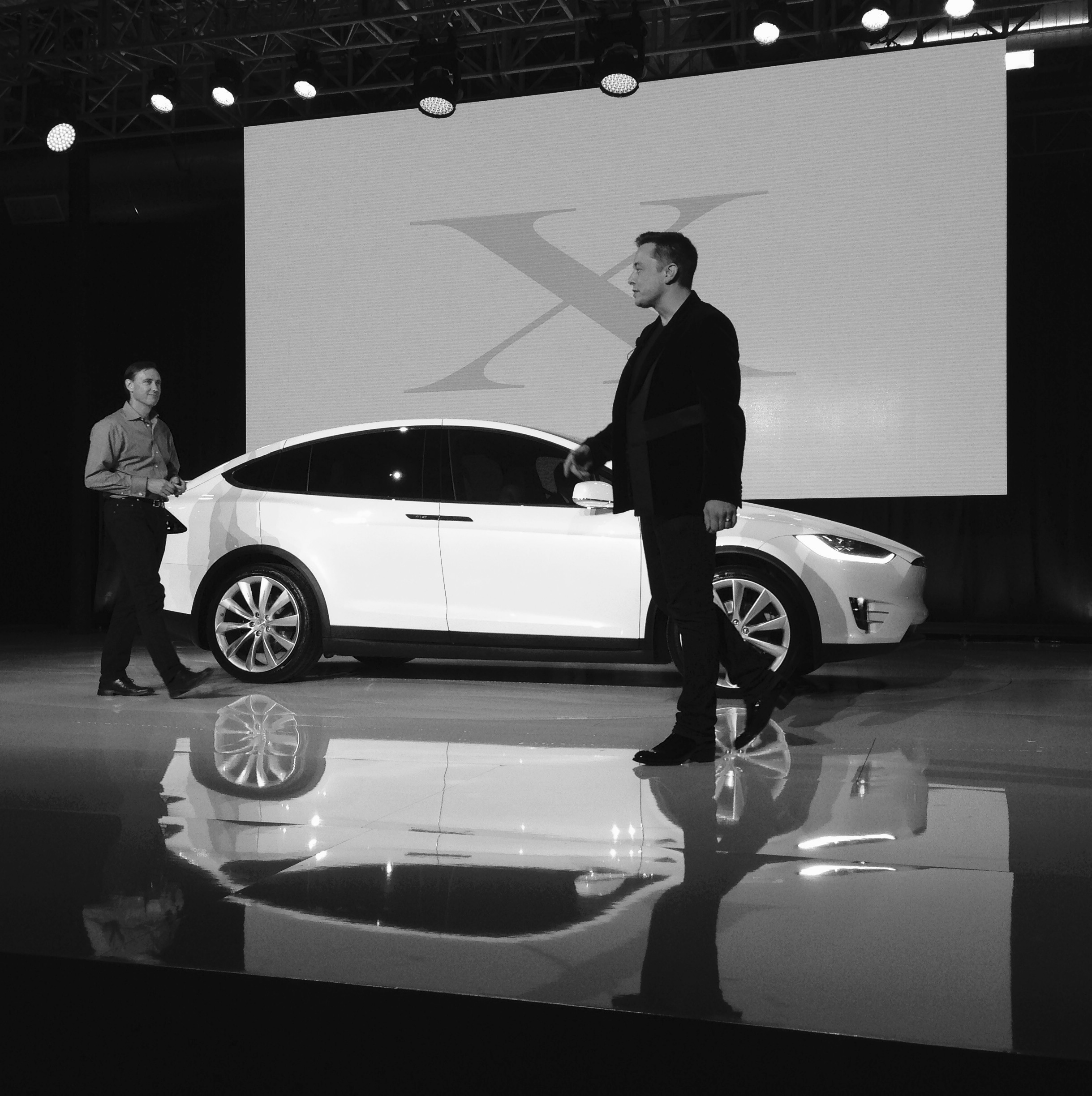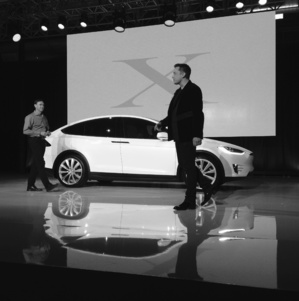They haven’t got an AGV as it is fully understood yet. But the latest firmware update of Model S and Model X on-board computers, being sent to users since October 14, contains the Autopilot function, implementing significant automation of driving. Ordinary people have been able to test it for more than a week now.
If you have not appreciated the scale of what happened, think about this. Until now, despite all the success AVG-development (Google, etc.), none AGV ran its way with a simple man on board. Everything that we have seen and heard from pioneers carmakers was just experiments with different varieties, always carried out under the supervision of specialists. Nobody would let a man off the street in an AGV. And the biggest barrier is not technical difficulties (think back about Google cars), but the inertia of society and the law. Put simply, the society is not ready to release a self-guided vehicle from the lab - in fact, there is no guarantee of safety for humans. We do not trust robots this much! And that’s where comes into play Tesla Motors and Musk. They were the first who took a chance and could release an AGV with a driver without special training sitting at the wheel.
But how they did it and how they decided on it? Everything will become clear if we recall the original idea. Musk did not and does not believe in the possibility of building an automatic car - that is, one that would be one hundred percent of the time managed independently. He believes that the road will always be something that a robot cannot handle, something that cannot be taught to a robot, no matter how many dollars developers spent on it. That is why Musk was going to build an automated car - relieving a person from having to steer 90% of the way, but the remaining ten entrusting itself to the man. The ten percent are likely to be the yards, alleys and other places where there is no marking, with occasional repairs and unpredictable pedestrians. Now we are seeing the first result.
For less than two weeks that passed from the date of the release, thousands people have already tried the cars, and some even put a few records. Three American motorsport fanatics, sitting in a Model S with the new firmware version, overcame nearly five thousand kilometers from California to New York in less than 58 hours. This is a record for range and speed riding. Yet the most valuable thing is not the distance and speed: it is that the car was moving on autopilot 96% of the time. A striking match with Musk’s words two years old.
However, coincidence and chance are not all about Musk. The example of the AGV shows that he owes to his paranoid precaution. Tesla Motors have long been producing vehicles equipped with all the necessary hardware for auto-piloting: ultrasonic sensors, radars and cameras, special brakes, a powerful computer. So, a driver can activate the autopilot simply by updating the software, without check-in at service. Besides, the fact that it is only about automation, not the automatic driving, opens all roads to Tesla cars.
Of course, the Tesla Motors autopilot is an AGV yet. According to Elon Musk, automated vehicles are capable of many things, but they do not relieve a person from having to watch the road. So Tesla autopilot can independently drive on motorways and easy roads, monitor traffic around and therefore change the speed, change lanes, look for a free parking space and park – yet all of this requires that the driver never leave the steering wheel for longer than a few seconds. So is it fully automated? No. But given that similar functions in other manufacturers’ vehicles are implemented in a smaller volume and do not relate to each other, the Model S and Model X autopilot brings the car to the category of AGV as close as possible.
And now, here is a problem about which we barely thought. People perceive such a car as a new digital toy, like a smartphone. They do not understand or do not want to understand the mortal danger of errors - at least as long as a person does not fall into a dangerous situation.
Some of the reckless drivers have already been fined for scorching - because the AGV did not understand that it’s got in limited speed area, and the driver did not bother to follow the manufacturer's recommendations and limit the speed. Another nearly killed himself - barely having time to correct the autopilot’s mistake, rushed into oncoming lane after a small hill. Clearly, it’s just the beginning: the flow of amateur videos showing “field tests” of Tesla Motors autopilot hasn’t dried out.
The guys, who crossed the continent in the Model S, confirm that a driver need to look after the autopilot: it does not behave like a human (especially in curves), and this affects the high speeds. Of course, obvious mistakes are going to corrected: Tesla Motors considers road experience and has already released the first patch. But who will correct the human factor?
source: engadget.com, mashable.com
If you have not appreciated the scale of what happened, think about this. Until now, despite all the success AVG-development (Google, etc.), none AGV ran its way with a simple man on board. Everything that we have seen and heard from pioneers carmakers was just experiments with different varieties, always carried out under the supervision of specialists. Nobody would let a man off the street in an AGV. And the biggest barrier is not technical difficulties (think back about Google cars), but the inertia of society and the law. Put simply, the society is not ready to release a self-guided vehicle from the lab - in fact, there is no guarantee of safety for humans. We do not trust robots this much! And that’s where comes into play Tesla Motors and Musk. They were the first who took a chance and could release an AGV with a driver without special training sitting at the wheel.
But how they did it and how they decided on it? Everything will become clear if we recall the original idea. Musk did not and does not believe in the possibility of building an automatic car - that is, one that would be one hundred percent of the time managed independently. He believes that the road will always be something that a robot cannot handle, something that cannot be taught to a robot, no matter how many dollars developers spent on it. That is why Musk was going to build an automated car - relieving a person from having to steer 90% of the way, but the remaining ten entrusting itself to the man. The ten percent are likely to be the yards, alleys and other places where there is no marking, with occasional repairs and unpredictable pedestrians. Now we are seeing the first result.
For less than two weeks that passed from the date of the release, thousands people have already tried the cars, and some even put a few records. Three American motorsport fanatics, sitting in a Model S with the new firmware version, overcame nearly five thousand kilometers from California to New York in less than 58 hours. This is a record for range and speed riding. Yet the most valuable thing is not the distance and speed: it is that the car was moving on autopilot 96% of the time. A striking match with Musk’s words two years old.
However, coincidence and chance are not all about Musk. The example of the AGV shows that he owes to his paranoid precaution. Tesla Motors have long been producing vehicles equipped with all the necessary hardware for auto-piloting: ultrasonic sensors, radars and cameras, special brakes, a powerful computer. So, a driver can activate the autopilot simply by updating the software, without check-in at service. Besides, the fact that it is only about automation, not the automatic driving, opens all roads to Tesla cars.
Of course, the Tesla Motors autopilot is an AGV yet. According to Elon Musk, automated vehicles are capable of many things, but they do not relieve a person from having to watch the road. So Tesla autopilot can independently drive on motorways and easy roads, monitor traffic around and therefore change the speed, change lanes, look for a free parking space and park – yet all of this requires that the driver never leave the steering wheel for longer than a few seconds. So is it fully automated? No. But given that similar functions in other manufacturers’ vehicles are implemented in a smaller volume and do not relate to each other, the Model S and Model X autopilot brings the car to the category of AGV as close as possible.
And now, here is a problem about which we barely thought. People perceive such a car as a new digital toy, like a smartphone. They do not understand or do not want to understand the mortal danger of errors - at least as long as a person does not fall into a dangerous situation.
Some of the reckless drivers have already been fined for scorching - because the AGV did not understand that it’s got in limited speed area, and the driver did not bother to follow the manufacturer's recommendations and limit the speed. Another nearly killed himself - barely having time to correct the autopilot’s mistake, rushed into oncoming lane after a small hill. Clearly, it’s just the beginning: the flow of amateur videos showing “field tests” of Tesla Motors autopilot hasn’t dried out.
The guys, who crossed the continent in the Model S, confirm that a driver need to look after the autopilot: it does not behave like a human (especially in curves), and this affects the high speeds. Of course, obvious mistakes are going to corrected: Tesla Motors considers road experience and has already released the first patch. But who will correct the human factor?
source: engadget.com, mashable.com






